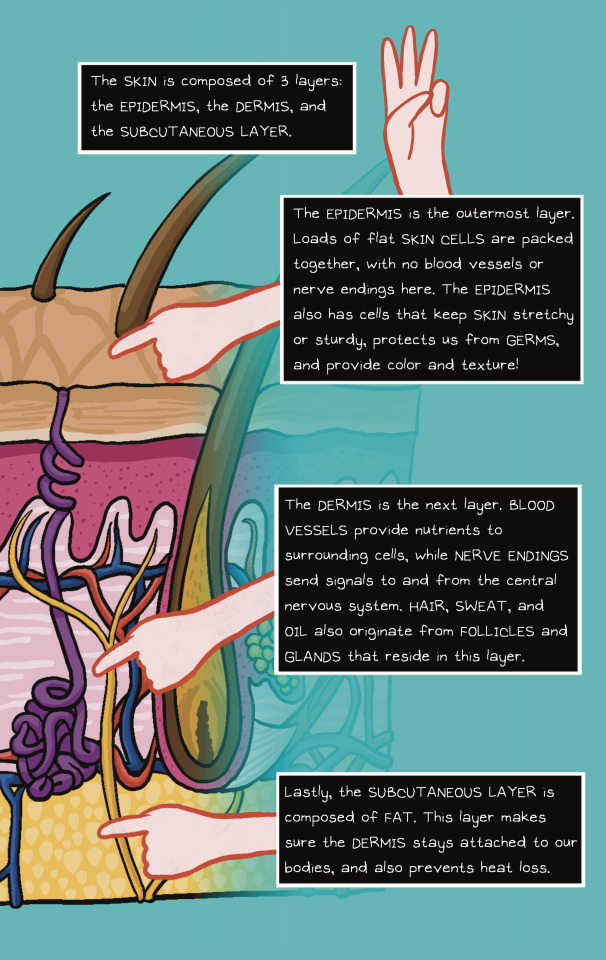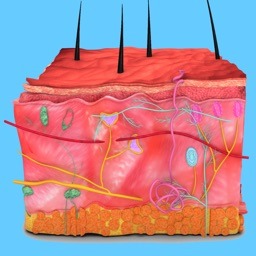#integumentary system
Text
The Human Body
It comprises living cells and extracellular materials, organized into tissues, organs, and systems.
It is primarily composed of water and organic compounds, lipids, proteins, carbohydrates, and nucleic acids.
Water, making up about 60% (varies by age) of body weight, is crucial for life's chemical processes, found in both extracellular fluids and within cells, serving as a vital solvent.
The skin and related structures form the integumentary system, safeguarding the body from harmful invaders and chemicals while also preventing water loss.
Comprising skeletal muscles and bones (about 206 in adults), the musculoskeletal system facilitates body movement and shields internal organs.
Incorporating breathing passages, lungs, and respiratory muscles, the respiratory system acquires vital oxygen from the air for cellular metabolism and expels waste carbon dioxide.
The circulatory system, comprising the heart, blood, and vessels, circulates fluid throughout the body, furnishing cells with oxygen and nutrients while removing waste like carbon dioxide and toxic compounds.
The digestive system comprises the mouth, esophagus, stomach, and intestines, breaks down food into usable nutrients, absorbing them into the bloodstream, and eliminates the remaining waste as feces.
Consisting of kidneys, ureters, bladder, and urethra, the excretory system filters toxins and waste from the blood for elimination.
The nervous system formed by sensory organs, brain, spinal cord, and nerves transmits sensory data, integrates it, and triggers appropriate muscular or glandular responses.
Composed of hormone-secreting glands and tissues, the endocrine system coordinates body processes via a chemical communication network.
The reproductive system, encompassing male or female sex organs, plays a crucial role in facilitating reproduction.
In males, this system includes structures such as the testes, which produce sperm, and in females, it comprises the ovaries, which produce eggs.
📹 (✏️) : SciePro
#human body#water#skin#musculoskeletal system#respiratory system#circulatory system#digestive system#excretory system#nervous system#endocrine system#reproductive system#integumentary system#science
17 notes
·
View notes
Text
Eccrine Sweat Glands
-- located in the dermis
-- found all over the body
-- begin working immediately following birth
-- produce clear liquid called perspiration
-- perspiration consists of water and salts
-- a type of suderiferous gland
-- more numerous than apocrine sweat glands
#medblr#studyblr#notes#my notes#medical notes#medblr notes#med notes#anatomy and physiology#anatomy#physiology#anatomy notes#physiology notes#eccrine sweat glands#eccrine sweat glands notes#integumentary system#integumentary system notes
10 notes
·
View notes
Photo

Convergence of the self
#my art lol#maplesleep art#digital art#halloween#inktober#body horror#body systems#spooky#ghost#anatomy#integumentary system#horror#Digital Illustration#skeletal system#nervous system#soul#lol so this took much longer than i wanted#hopefully i can get out one more spooky month piece out in time
31 notes
·
View notes
Text




HERO's Incomprehensible Cookbook... of Medicine - featuring the integumentary system!
On the flip side of me learning the musculoskeletal system... there isn't a lot about the integumentary system that 1) I've learned about across a few survey classes, 2) doesn't also include cancer, or 3) doesn't involve very gross-looking symptoms. Or maybe I didn't find this topic particularly interesting lol.
Hero, Kel, and Aubrey are from the RPG OMORI.
11 notes
·
View notes
Text
Integumentary Accessory Structures: Nails
Integumentary Accessory Structures: Nails
Within the integumentary system, four main accessory structures aid in thermoregulation, sense of touch, protection, and much more. These four main accessory structures are:
Hair FolliclesNailsSebaceous GlandsSweat Glands
https://teachmeanatomy.info/upper-limb/misc/nail-unit/
The nails can be found on the tips of your toes and fingers. The main function of these structures is to protect these…

View On WordPress
#accessory structure#anatomy#animals#biology#blog#college#cuticle#dermis#eponychium#facts#fingers#follow#glands#hair#Integumentary system#keratin#lunula#nail bed#nail fold#nail plate#nail root#nails#nature#phalanx#photography#science#subscribe
7 notes
·
View notes
Text

A thing we did in my medical terminology class for the integmentuary system (yeah definitely spelled that wrong)
We used a variety of different candies and a rice Krispy as the base. It is edible and sitting on my desk wrapped in a coloring page.
Sorry for my shitty handwriting lol
2 notes
·
View notes
Text

Thank u Pinterest that's exactly what I want to see. Wesley Crusher, Back to the Future, Star Trek Original, Star Trek Voyager, and ✨integumentary system✨
2 notes
·
View notes
Text
invincibility
hey tumblr, quick question put if someone had semi invulnerability, like their integumentary system like their skin was the only invulnerable part then could they still break a bone?
the bones aren’t invulnerable only like the skin.
this question comes from someone who has never broken a bone so if you could tell me how that also works that would be nice.
this also comes from someone who overthinks things a lot, so I was left with a lot of questions and extremely confused.
Plz help me.
#superpowers#invulnerability#superheroes#bones#how does it work#send help#please#Integumentary system
0 notes
Text
i'm almost done with this stupid fucking chapter i just have one quiz and the test left and i can move onnnnnnnnn
#whiny baby post#fuck the integumentary system !!!!#stop having so many things you can have wrong !#and so many ways to fix those things !!!
1 note
·
View note
Text
Histology of Integumentary system Notes
#MendelsLaws#HereditaryTraits#ScienceOfInheritance#MendelianInheritance#GeneticDiscoveries#BiologyLessons#MendelsPrinciples#GeneticsEducation#HereditaryScience#Histology of Integumentary system Notes
0 notes
Text
Hair
-- an accessory organ of the integumentary system
-- hair is made of keratin
-- the hair shaft projects from the skin
-- the root is embedded in the skin
-- the shape of the root determines whether hair is curly or straight
-- pigment (hair color) depends on melanocytes located in the follicle
-- the hair follicle contains the hair root
-- the hair follicle has nerve endings
-- papila = knot of capillaries that supply nutrients
-- arector pili muscles raise the hair
-- the arector pili muscles are made of bundles of smooth muscles
#medblr#studyblr#notes#my notes#medical notes#med notes#medblr notes#anatomy and physiology#anatomy#physiology#anatomy notes#physiology notes#integumentary system#integumentary system notes#hair#hair notes
9 notes
·
View notes
Text
Test Your Knowledge about skin, hair, nails with the Integumentary System Quiz.
Explore the skin you're in with our Integumentary System Quiz! Dive into this interactive experience and test your knowledge about skin, hair, nails, and more. Discover fascinating facts while uncovering the secrets of your body's largest organ system. learn more about the human body.

0 notes
Text
youtube
1 note
·
View note
Text
What is an oil gland? How does the sebaceous gland (lipoma) pass? 2023
New Post has been published on https://bankakredin.com/what-is-an-oil-gland-how-does-the-sebaceous-gland-lipoma-pass-2023/
What is an oil gland? How does the sebaceous gland (lipoma) pass? 2023
Sebaceous glands , medical term lipomaThey are fat-filled and usually small, tumor-like formations that occur in any part of the body. The sebaceous glands, which can be of various sizes, are surrounded by a capsule and are visible in white-yellow colors. While fat formation can be observed at any age in adulthood, the incidence of this problem in children is quite low.
Sebaceous glands located in visible parts of the body are generally undesirable because they disturb the individual visually. Methods such as squeezing these glands at home and emptying them with a needle both pose a risk of infection and cause scarring in the area where the oil gland is located. For this reason, the procedures to be performed for the removal of the oil glands must be carried out by the physician in a health institution using appropriate equipment.
What is an oil gland?
The encapsulation of the fat deposits in the body by settling under the skin results in the formation of sebaceous glands, also called lipomas. These glands, which can also be described as a simple form of tumor, are generally benign and do not cause any health problems, except for disturbing people in terms of appearance.
While sebaceous glands can be seen in all parts of the body, it most commonly occurs on the face, shoulders, scalp, genital area, neck and back. Many have a soft texture and feel as if they are moving when pressed by hand. This is because they are not fully integrated with the skin. Although sebaceous glands are a problem that can be seen in people of all ages, it is rarely seen in children.
They usually do not cause pain. Pain in these types of glands, It is usually a condition that indicates that the sebaceous gland requires medical attention. Fat cells, which grow and multiply over time, like all cells, can in some cases cause the size of the sebaceous glands to get out of control and to overgrow. In these cases, it is necessary to remove the growing oil glands with the help of surgical operations.
What are the symptoms of sebaceous glands?
The first and most characteristic symptom of sebaceous glands is swelling in the tissue where the gland develops. This swelling can grow slowly and continuously. While the oil glands in the face vary from the size of a pinhead to a few millimeters, the swellings that occur in areas such as the back and neck are larger and deeper.
Again, in the formation of under-eye oil glands on the face and oil gland formation on the eyelid, it is possible that the oil mass inside can be easily seen due to the fact that the gland is white-yellow in color and the skin covering it is very thin. In deep sebaceous glands formed in other parts of the body, since the gland is located in the lower layers of the skin, only swelling is felt, the fat layer cannot be seen from the outside.
They usually do not cause pain. But if the meringue is hit, In case of infection or malignancy, the sebaceous glands may cause pain or discharge over time. Especially in cases of rapid growth, color change, redness and severe pain, lipomas should be removed with the help of surgical procedures and sent for pathological examination.
What causes oil glands?
The exact cause of the formation of oil glands is not known. However, there are some issues that are known to increase the probability of occurrence. Some of the factors that predispose to the formation of sebaceous glands are as follows:
Genetic predisposition
Impact of the skin
High cholesterol and triglyceride levels
metabolic diseases
Unhealthy eating
advanced age
Insulin resistance and diabetes
Liver diseases
Obesity
What are the types of oil glands?
Oil glands are examined under 3 different groups according to their structures. These are as follows:
Sebaceous cysts: Sebaceous cysts , which are commonly seen on the scalp, are not completely glandular, but consist of a fluid fat mass and a very thin layer of skin covering it.
Benign adipose tissue tumors: Adipose tissue tumors , which have a glandular structure commonly seen in the neck and back regions, are generally benign and fall into this group. The fat mass in it is light yellow in color and has a hard structure. Just like other types of cysts, they can reach large sizes and therefore need to be surgically removed.
Malignant adipose tissue tumors: Masses formed as a result of cancerization of the subcutaneous fatty tissue are called malignant adipose tissue tumors. The fluid in these tumors, also called liposarcoma, has a yellow to grayish color. This rare type of sebaceous gland is softer and must be removed with the help of surgical operations.
Apart from the above grouping, the under-eye oil glands are also divided into three. These are examined under 3 subheadings: thin layers of fat called xanthelasma, which occur due to high cholesterol, small round fat cysts called syringoma, and miliums that are smaller than syringoma and have a fainter appearance.
How is the diagnosis of sebaceous gland made?
Visible sebaceous glands can only be detected by physicians by physical examination. Sebaceous cysts usually have a round structure, a spot in the middle and a slightly reddened appearance. In many types of sebaceous glands, the fat mass under the skin is displaced when pressed by hand. A fixed swelling that does not move easily may indicate a different disease.
Although it may vary according to the region where it occurs, lipomas generally have a soft structure and may change shape when pressed during manual examination. In the diagnosis of larger and hard sebaceous glands, the diagnosis can be supported by ultrasonographic imaging in order not to be confused with different diseases with similar appearance.
How is the oil gland treatment done?
Almost 99% of the sebaceous glands are benign and do not tend to become cancerous. However, especially the oil glands in visible parts of the body such as the face and neck do not look aesthetically pleasing and cause discomfort in patients. In addition, although adipose tissue tumors in the back region do not pose any risk to health, they can cause pain due to pressure in situations such as leaning back and using a backpack.
Infection may develop as a result of blows in some oil glands or spontaneously, and accordingly symptoms such as pain, redness, discharge and fever may occur. In all these cases, the glands should be removed with the help of a simple surgical operation, also known as oil gland removal.
This operation is performed under local anesthesia. usually completed in less than half an hour. It does not require hospitalization, patients can be discharged on the same day and return to their daily lives the next day.
In cases where the sebaceous glands do not cause any discomfort to the individual in terms of aesthetic appearance or health, they may not need to be removed. However, it should be kept in mind that these masses may be malignant, albeit very rarely. For this reason, in some cases, a biopsy can be taken for masses that are suspected to be cancerous or that tend to grow rapidly.
By performing a pathological examination of this sample, it can be determined whether the mass is benign or malignant, and the next treatment process can be planned according to this result. If you have sebaceous glands in any part of your body and are wondering how the sebaceous glands go away, you can go through a doctor’s control by applying to a health institution and get rid of the sebaceous glands that bother you.
oil gland,are oil glands part of the integumentary system,are oil glands located in the epidermis,are oil glands in the epidermis,are oil glands,where are oil glands in eyes,where are oil glands located,what are oil glands called,where are oil glands located in the skin,where are oil glands on face,where are oil glands found,can oil glands be removed,bacterial infection of an eyelid oil gland codycross,what is an oil gland cyst,an inflammation of oil gland caused by a bacteria,what causes an infected oil gland,an oil gland is called,can oil glands cause acne,do chickens have an oil gland,can you pop a clogged oil gland,
#an inflammation of oil gland caused by a bacteria#an oil gland is called#are oil glands#are oil glands in the epidermis#are oil glands located in the epidermis#are oil glands part of the integumentary system#bacterial infection of an eyelid oil gland codycross#can oil glands be removed#can oil glands cause acne#can you pop a clogged oil gland#do chickens have an oil gland#oil gland#what are oil glands called#what causes an infected oil gland#what is an oil gland cyst#where are oil glands found#where are oil glands in eyes#where are oil glands located#where are oil glands located in the skin#where are oil glands on face
0 notes
Text
Subcutaneous Layer
The first layer below the cutaneous membrane is called the subcutaneous layer. It is also known as the hypodermis and superficial fascia. Although this layer helps stabilize the integumentary system and shares some characteristics, it is not technically a part of the integumentary system.
https://my.clevelandclinic.org/health/body/21902-hypodermis-subcutaneous-tissue
Within the subcutaneous…

View On WordPress
#animals#biology#blog#collagen#college#cutaneous membrane#dermis#elastic#epidermis#estrogen#facts#follow#hypodermic needle#hypodermis#Integumentary system#layers of the skin#nature#photography#science#skin#subcutaneous#subscribe#testosterone
3 notes
·
View notes
